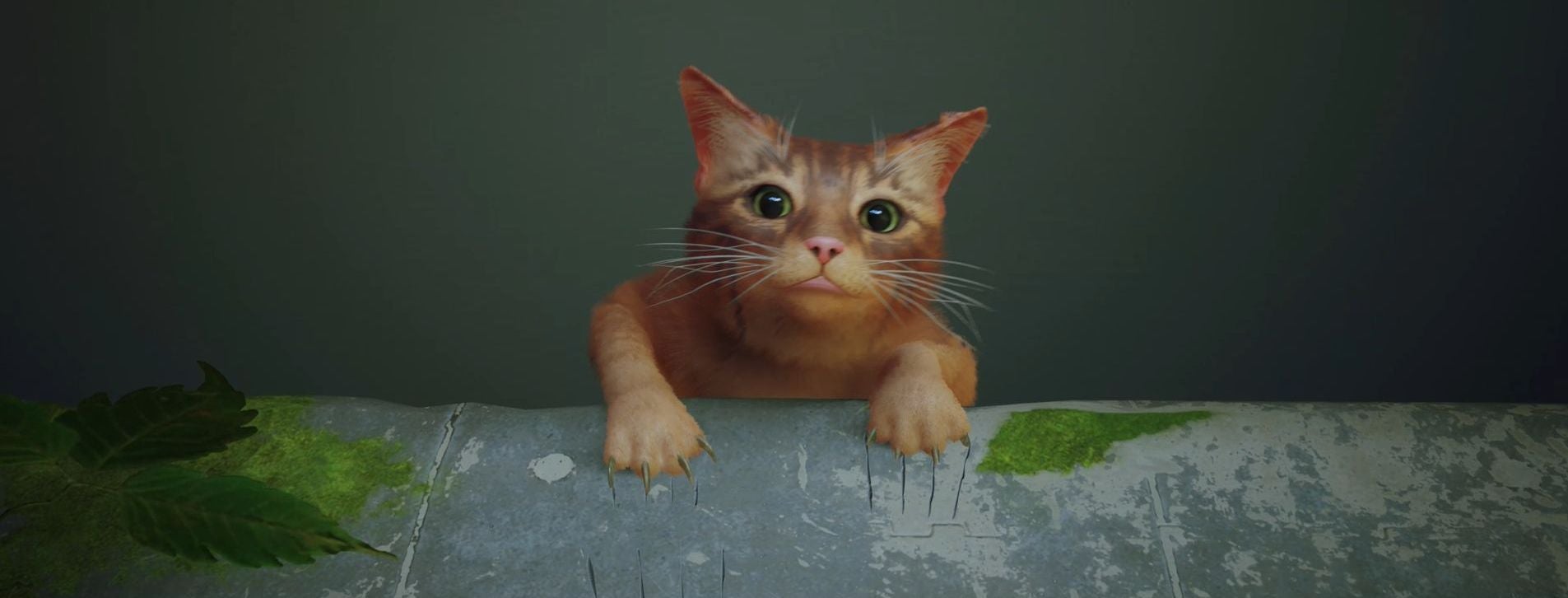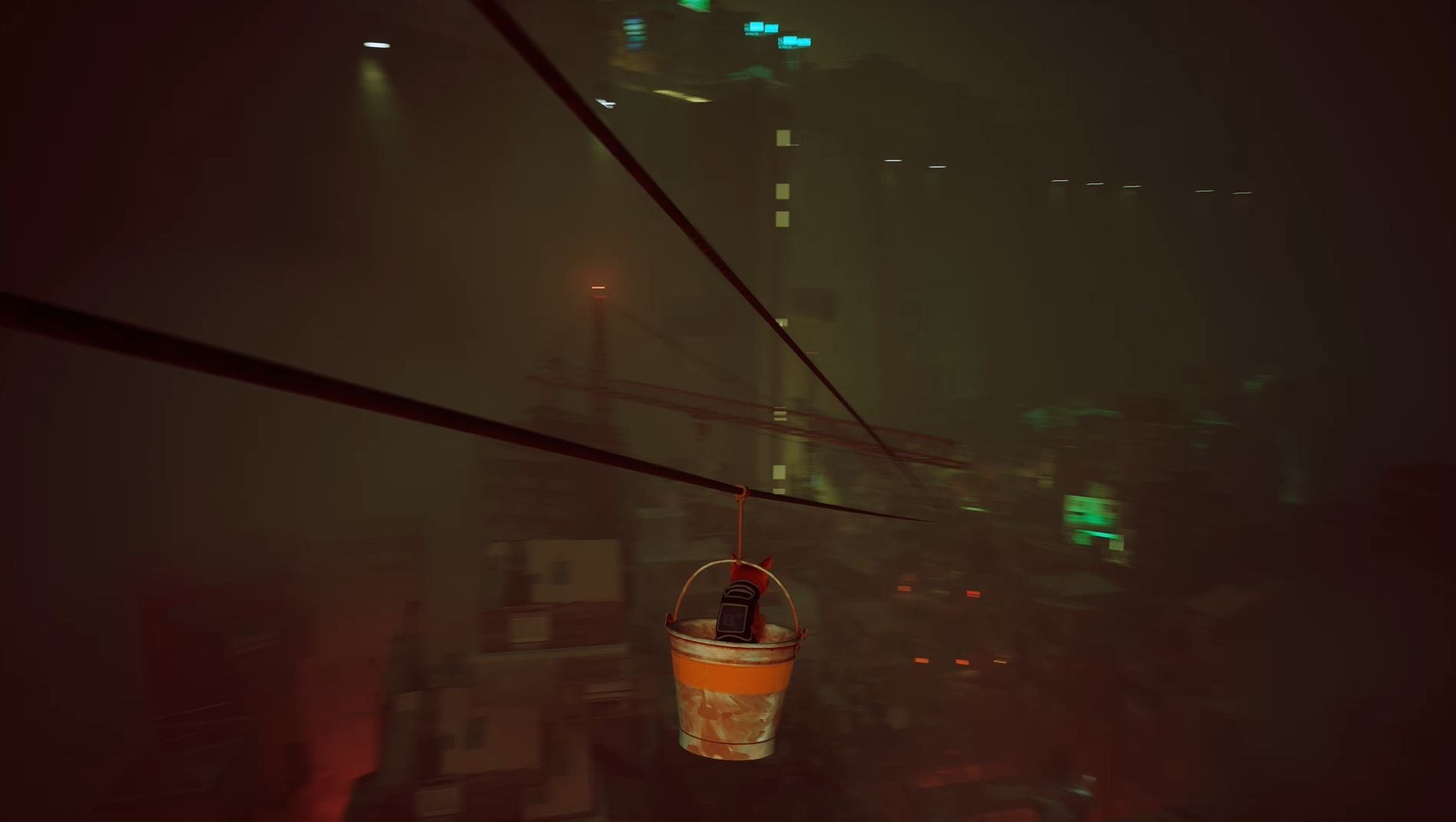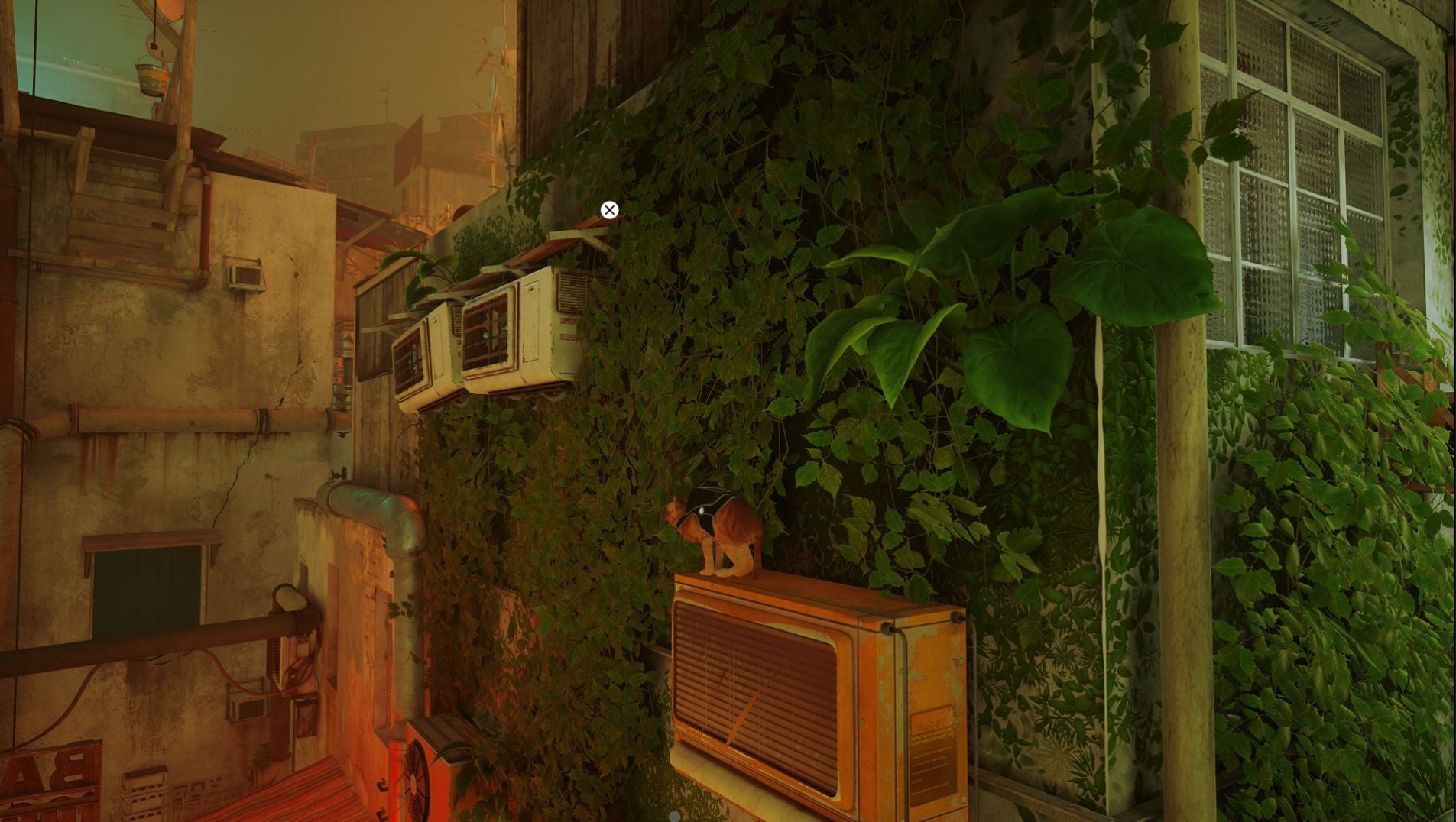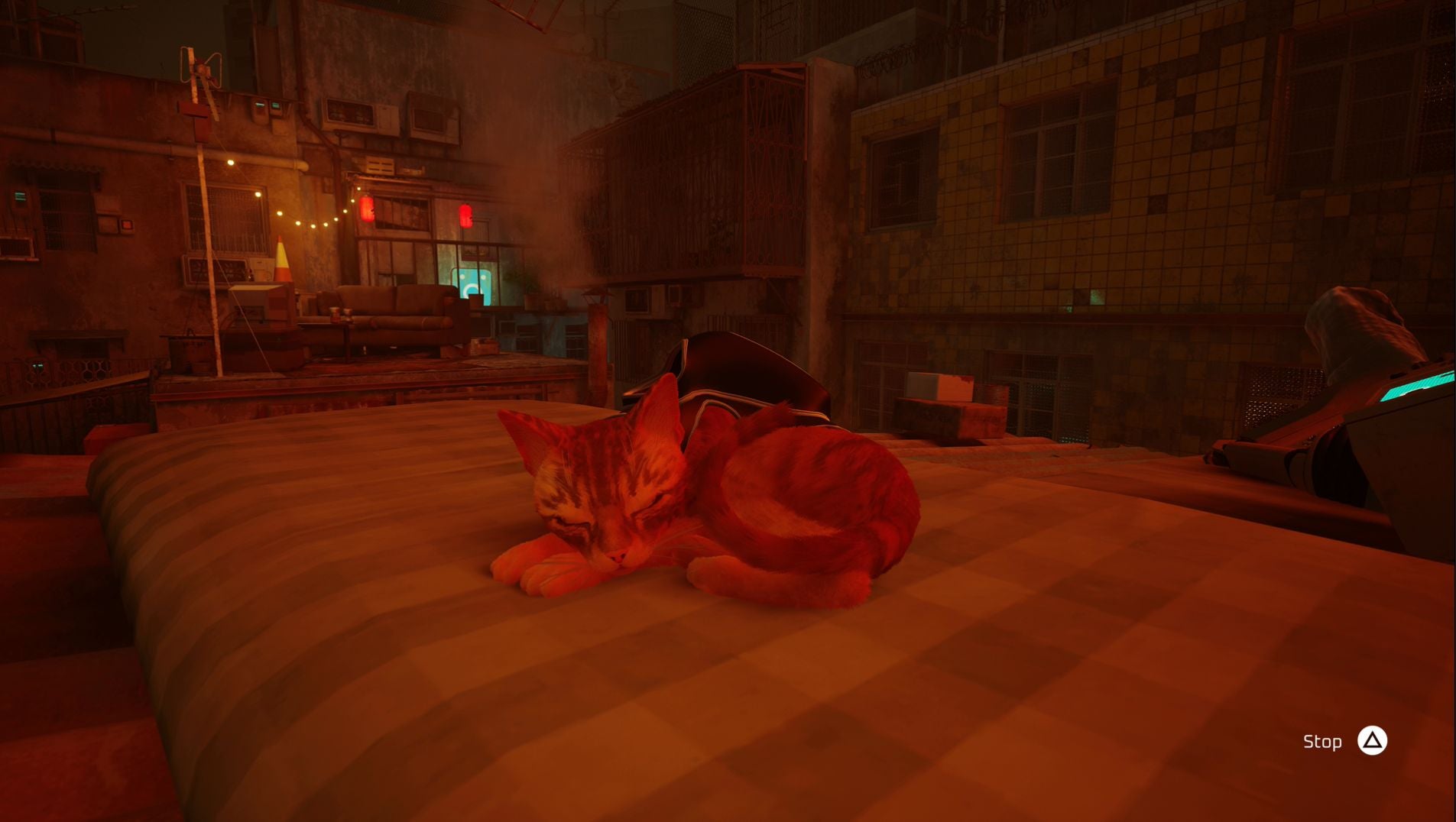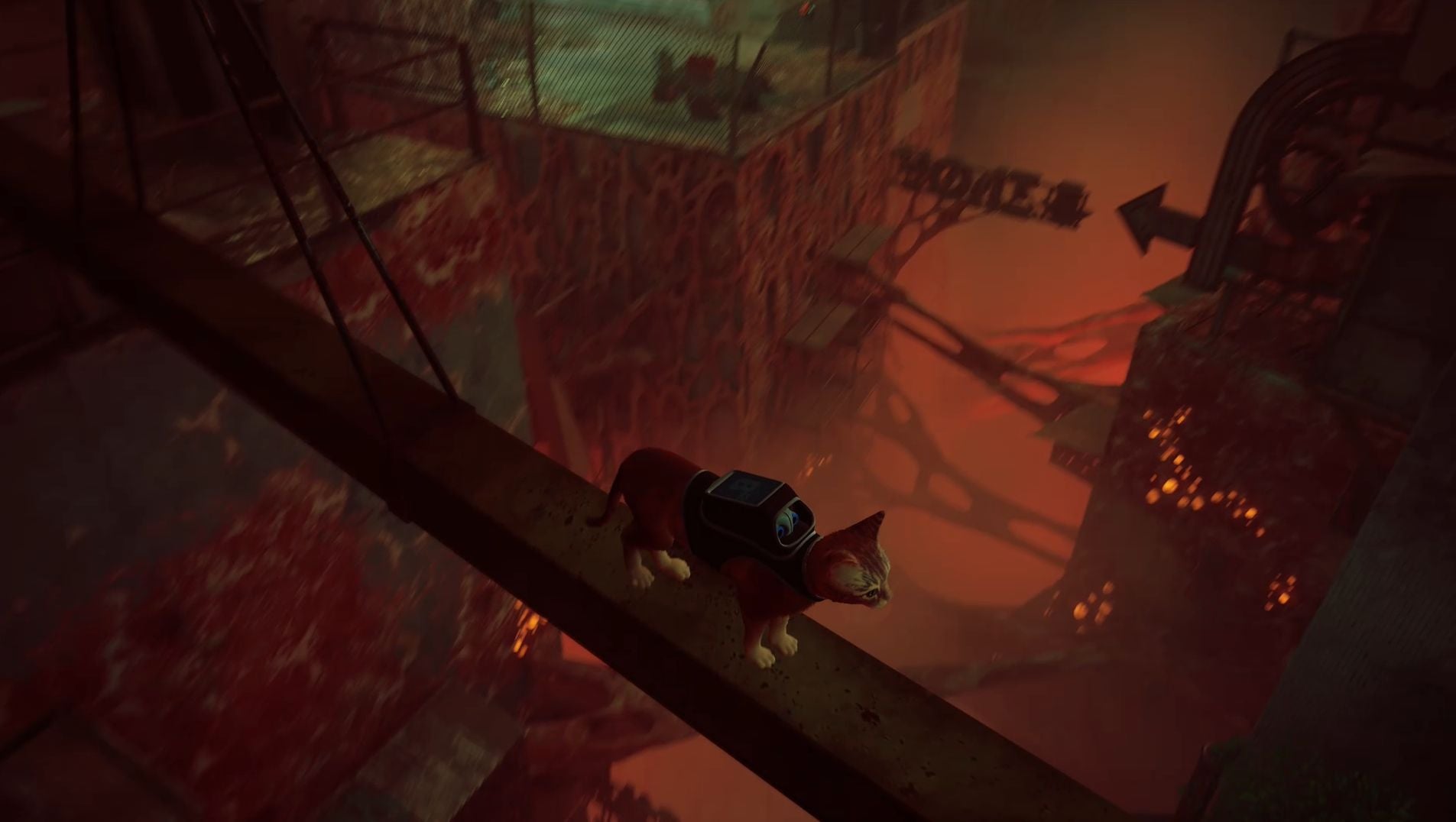On the surface, this is a game that tells a simple science-fiction of a cat who, after falling into the city’s underbelly, Lion-King-style, must escape a mysterious place with the hope of reuniting with their family. But beneath that is something more. Still, when it comes to simply recreating the experience of being a cat, developer BlueTwelve Studio has done a wonderful job; playing as a cat feels unique, while also being surprisingly easy to master. It’s all the little features, though, that truly capture a cat’s essence, from knocking items off ledges to the little pawprints you leave behind after walking through wet paint, or how the controls invert when you investigate a paper bag. None of these are purely cosmetic things, either, with each screensaver-like moment coming to serve a purpose in your journey. Meowing, for example, can attract enemies so you can trap them, while scratching at a blind can reveal a window to climb through. Even sleeping goes beyond the sheer cuteness of the moment by causing the camera to zoom out, so you get a wider view of your current location. Stray is constantly encouraging you to explore like this - to discover how high the cat can climb. Helpfully, the act of navigating the city itself is also an incredible amount of fun. Your ginger paws weave across rooftops and clamber up the sides of buildings one air vent at a time, while exploring through the feline perspective emphasises just how labyrinthine the city is, with the possibility of dead ends or danger around any corner. Nearly every object you encounter can be climbed or jumped on - why take the stairs, when you can run along the handrail after all? While ziplines (you hop into a little bucket, in case you were wondering how a cat might manage that) provide a quick descent from high places, giving you a good look at your surroundings as you fall. You’ll quickly learn that there are multiple ways to reach certain locations, especially in the slums where you may find yourself abandoning the alleyways in favour of the roofs. As your confidence grows, you’ll spend less time planning your routes, instead jumping naturally, much like how a cockey alley cat would out on the real streets of your town. The only, very small, hitch to your roleplaying is how you can’t customise or change the cat’s breed, but this doesn’t stop you from embodying the type of cat who lives within your soul. Are you a snuggle beast always on the lookout for robots to rub against or sleep on? Perhaps you’re a dedicated climber? Or maybe you’re a force of chaos - prepared to scratch every wall, knock down every book pile and meow constantly through every cutscene. Aside from immersing yourself in the cat mindset, another important side to Stray is its puzzling. Traversing the city will lead you to encountering a range of environmental puzzles which are solved by using the abandoned debris; a barrel can be positioned near an out-of-reach ledge, for example, by rolling the container from the inside. Delving deeper into the cybercity will lead to puzzles where you must work alongside B-12 - the drone you befriend - by completing certain acts, like leading enemies astray, while it hacks a machine. (Though it doesn’t follow the hacker tradition of ‘green text on a black screen,’ so I’m a little doubtful of its skills.) While the environmental puzzles are quite short, the longer puzzle sequences involve hunting down a robot or item, therefore transforming you into a cat detective. These sequences are some of my favourite parts of Stray, because it allows you to solve certain sections before they gain plot relevance, preventing you from feeling forced along by the game’s narrative. I had a poncho in my inventory for a good hour before it was actually needed - admittedly I thought I was receiving a cat sized poncho, but alas. This freedom results in very rewarding moments when you realise a small, almost random, action you completed a while ago is now the key for progression. Weaving through all this, Stray tells its story through a series of chapters, some releasing you into an open area perfect for investigation, while others focus around navigating a section of the decaying city. While the latter follows a far more linear structure, they still provide engaging challenges, especially when it comes to avoiding Zurks - the fleshy, one-eyed, grub-like creatures who will happily eat the cat if given the chance. Stray does allow you to revisit any past chapter without consequence, granting you an element of control over its linearity so you can find a missing collectible or engage in even more cat antics. There are a few diversions from Stray’s main quest, with the best, and longest, tasking you to restore B-12’s corrupted memories. It’s reminiscent of the memory locations from The Legend of Zelda: Breath of the Wild, except instead of beautiful vistas, you’re given glitchy pictures of a wall, plant or hidden nook which you have to find within the city. It’s another way in which Stray encourages exploration - while some are encountered by simply following the plot, the majority of the memories hide off the beaten tracks. Like any good cat would, you must slip through broken fences and lurk in alleyways to find them all. Doing so will help you piece together more of the city’s history and what led to its current state. Yet, the further you roam, the more Stray reveals it is also the tale of B-12, the robots and the city itself. B-12 undertakes a journey of self-discovery, growing beyond a useful companion who carries your inventory and illuminates dark corners, by travelling alongside you. Through the robots you witness their attempts to carve out an existence, but learn their efforts are being stifled due to the actions and society structure created by the long dead. During your travels, you’ll meet a group of robots called the Outsiders longing to escape the city and assist another in finding his missing father. (We’re not going to tackle robot reproduction here - let’s move on.) Part of the city’s history is told through environmental storytelling - posters, graffiti and a recurring date all hint at what happened long ago. These different threads combine into one larger narrative about the lengths people will take to survive and how this desire can become polluted. Which thread captures you the most will differ depending on your taste - for me, it was the city. Stray’s city is a claustrophobic construction of houses squeezed tightly together, minuscule safe open spaces and neon lights offering harsh comfort in the endless night. The only glimpse of the outside world within its walls are repeated pictures of a tropical beach and, oddly, the occasional cow picture, which start to feel mocking as you wonder how long it’s been since daylight touched the city. There are times when you truly comprehend its scale - ziplining across the skyline or simply standing above the areas you’ve previously explored - and, within these moments, the city feels immense, but then you notice how the orange glow of the Zurk’s flesh structures are steadily encroaching on the small spots of robot sanctuary. On your expedition through the sewers you learn, through a delicious piece of body horror, this is a fight the robots will lose. Gradually, the city reveals itself to be a prison - one where the robots are trapped at the bottom of a pit, subject to the failings of those who came before, as spotlights shine like false stars from the roof above. It’s by doing this - looking at the world through feline eyes - that Stray creates a journey filled with such a sense of exploration, on top of the chance to indulge in as much cat-truction as you like. While doing so, though, it also crafts a touching story about the human desires of those who, at a glance, lack humanity - be it to reunite with a loved one, protect a community or reach the outside world. The result is a wonderful mix: a game about the longing for freedom, clever climbing mechanics, and every cat’s eternal desire to knock items off shelves.

